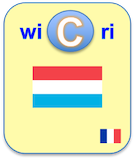Links to Exploration step
Le document en format XML
<record><TEI><teiHeader><fileDesc><titleStmt><title xml:lang="en">Forces generated during actin-based propulsion: A direct measurement by micromanipulation</title><author><name sortKey="Marcy, Yann" sort="Marcy, Yann" uniqKey="Marcy Y" first="Yann" last="Marcy">Yann Marcy</name><affiliation><nlm:aff wicri:cut="; and" id="N0x9ce5828.0x9704d28">Laboratoire Physico-Chimie Curie, Unité Mixte de Recherche 168 Institut Curie, Centre National de la Recherche Scientifique, 11 Rue Pierre et Marie Curie, 75231 Paris Cedex 5, France</nlm:aff></affiliation></author><author><name sortKey="Prost, Jacques" sort="Prost, Jacques" uniqKey="Prost J" first="Jacques" last="Prost">Jacques Prost</name><affiliation><nlm:aff wicri:cut="; and" id="N0x9ce5828.0x9704d28">Laboratoire Physico-Chimie Curie, Unité Mixte de Recherche 168 Institut Curie, Centre National de la Recherche Scientifique, 11 Rue Pierre et Marie Curie, 75231 Paris Cedex 5, France</nlm:aff></affiliation></author><author><name sortKey="Carlier, Marie France" sort="Carlier, Marie France" uniqKey="Carlier M" first="Marie-France" last="Carlier">Marie-France Carlier</name><affiliation><nlm:aff id="N0x9ce5828.0x9704d28">Dynamique du cytosquelette, Laboratoire d'Enzymologie et de Biologie Structurale, Centre National de la Recherche Scientifique, 91198 Gif-sur-Yvette, France</nlm:aff></affiliation></author><author><name sortKey="Sykes, Cecile" sort="Sykes, Cecile" uniqKey="Sykes C" first="Cecile" last="Sykes">Cecile Sykes</name><affiliation><nlm:aff wicri:cut="; and" id="N0x9ce5828.0x9704d28">Laboratoire Physico-Chimie Curie, Unité Mixte de Recherche 168 Institut Curie, Centre National de la Recherche Scientifique, 11 Rue Pierre et Marie Curie, 75231 Paris Cedex 5, France</nlm:aff></affiliation></author></titleStmt><publicationStmt><idno type="wicri:source">PMC</idno><idno type="pmid">15079054</idno><idno type="pmc">395911</idno><idno type="url">http://www.ncbi.nlm.nih.gov/pmc/articles/PMC395911</idno><idno type="RBID">PMC:395911</idno><idno type="doi">10.1073/pnas.0307704101</idno><date when="2004">2004</date><idno type="wicri:Area/PubMedCentral/Corpus">000022</idno><idno type="wicri:explorRef" wicri:stream="PubMedCentral" wicri:step="Corpus" wicri:corpus="PMC">000022</idno></publicationStmt><sourceDesc><biblStruct><analytic><title xml:lang="en" level="a" type="main">Forces generated during actin-based propulsion: A direct measurement by micromanipulation</title><author><name sortKey="Marcy, Yann" sort="Marcy, Yann" uniqKey="Marcy Y" first="Yann" last="Marcy">Yann Marcy</name><affiliation><nlm:aff wicri:cut="; and" id="N0x9ce5828.0x9704d28">Laboratoire Physico-Chimie Curie, Unité Mixte de Recherche 168 Institut Curie, Centre National de la Recherche Scientifique, 11 Rue Pierre et Marie Curie, 75231 Paris Cedex 5, France</nlm:aff></affiliation></author><author><name sortKey="Prost, Jacques" sort="Prost, Jacques" uniqKey="Prost J" first="Jacques" last="Prost">Jacques Prost</name><affiliation><nlm:aff wicri:cut="; and" id="N0x9ce5828.0x9704d28">Laboratoire Physico-Chimie Curie, Unité Mixte de Recherche 168 Institut Curie, Centre National de la Recherche Scientifique, 11 Rue Pierre et Marie Curie, 75231 Paris Cedex 5, France</nlm:aff></affiliation></author><author><name sortKey="Carlier, Marie France" sort="Carlier, Marie France" uniqKey="Carlier M" first="Marie-France" last="Carlier">Marie-France Carlier</name><affiliation><nlm:aff id="N0x9ce5828.0x9704d28">Dynamique du cytosquelette, Laboratoire d'Enzymologie et de Biologie Structurale, Centre National de la Recherche Scientifique, 91198 Gif-sur-Yvette, France</nlm:aff></affiliation></author><author><name sortKey="Sykes, Cecile" sort="Sykes, Cecile" uniqKey="Sykes C" first="Cecile" last="Sykes">Cecile Sykes</name><affiliation><nlm:aff wicri:cut="; and" id="N0x9ce5828.0x9704d28">Laboratoire Physico-Chimie Curie, Unité Mixte de Recherche 168 Institut Curie, Centre National de la Recherche Scientifique, 11 Rue Pierre et Marie Curie, 75231 Paris Cedex 5, France</nlm:aff></affiliation></author></analytic><series><title level="j">Proceedings of the National Academy of Sciences of the United States of America</title><idno type="ISSN">0027-8424</idno><idno type="eISSN">1091-6490</idno><imprint><date when="2004">2004</date></imprint></series></biblStruct></sourceDesc></fileDesc><profileDesc><textClass></textClass></profileDesc></teiHeader><front><div type="abstract" xml:lang="en"><p>Dynamic actin networks generate forces for numerous types of movements such as lamellipodia protrusion or the motion of endocytic vesicles. The actin-based propulsive movement of <italic>Listeria monocytogenes</italic> or of functionalized microspheres have been extensively used as model systems to identify the biochemical components that are necessary for actin-based motility. However, quantitative force measurements are required to elucidate the mechanism of force generation, which is still under debate. To directly probe the forces generated in the process of actin-based propulsion, we developed a micromanipulation experiment. A comet growing from a coated polystyrene bead is held by a micropipette while the bead is attached to a force probe, by using a specially designed “flexible handle.” This system allows us to apply both pulling and pushing external forces up to a few nanonewtons. By pulling the actin tail away from the bead at high speed, we estimate the elastic modulus of the gel and measure the force necessary to detach the tail from the bead. By applying a constant force in the range of –1.7 to 4.3 nN, the force–velocity relation is established. We find that the relation is linear for pulling forces and decays more weakly for pushing forces. This behavior is explained by using a dimensional elastic analysis.</p></div></front></TEI><pmc article-type="research-article"><pmc-comment>The publisher of this article does not allow downloading of the full text in XML form.</pmc-comment>
<front><journal-meta><journal-id journal-id-type="nlm-ta">Proc Natl Acad Sci U S A</journal-id><journal-id journal-id-type="publisher-id">pnas</journal-id><journal-title>Proceedings of the National Academy of Sciences of the United States of America</journal-title><issn pub-type="ppub">0027-8424</issn><issn pub-type="epub">1091-6490</issn><publisher><publisher-name>National Academy of Sciences</publisher-name></publisher></journal-meta><article-meta><article-id pub-id-type="pmid">15079054</article-id><article-id pub-id-type="pmc">395911</article-id><article-id pub-id-type="publisher-id">1015992</article-id><article-id pub-id-type="doi">10.1073/pnas.0307704101</article-id><article-categories><subj-group subj-group-type="heading"><subject>Biological Sciences</subject><subj-group><subject>Biophysics</subject></subj-group></subj-group></article-categories><title-group><article-title>Forces generated during actin-based propulsion: A direct measurement by micromanipulation</article-title></title-group><contrib-group><contrib contrib-type="author"><name><surname>Marcy</surname><given-names>Yann</given-names></name><xref ref-type="aff" rid="N0x9ce5828.0x9704d28">†</xref></contrib><contrib contrib-type="author"><name><surname>Prost</surname><given-names>Jacques</given-names></name><xref ref-type="aff" rid="N0x9ce5828.0x9704d28">†</xref></contrib><contrib contrib-type="author"><name><surname>Carlier</surname><given-names>Marie-France</given-names></name><xref ref-type="aff" rid="N0x9ce5828.0x9704d28">‡</xref></contrib><contrib contrib-type="author"><name><surname>Sykes</surname><given-names>Cecile</given-names></name><xref ref-type="aff" rid="N0x9ce5828.0x9704d28">†</xref><xref ref-type="corresp" rid="cor1">§</xref></contrib></contrib-group><aff id="N0x9ce5828.0x9704d28"><label>†</label>Laboratoire Physico-Chimie Curie, Unité Mixte de Recherche 168 Institut Curie, Centre National de la Recherche Scientifique, 11 Rue Pierre et Marie Curie, 75231 Paris Cedex 5, France; and<label>‡</label>Dynamique du cytosquelette, Laboratoire d'Enzymologie et de Biologie Structurale, Centre National de la Recherche Scientifique, 91198 Gif-sur-Yvette, France</aff><author-notes><fn id="cor1"><label>§</label><p> To whom correspondence should be addressed. E-mail: <email>cecile.sykes@curie.fr</email>. </p></fn><fn><p>Edited by Edward D. Korn, National Institutes of Health, Bethesda, MD, and approved March 3, 2004</p></fn></author-notes><pub-date pub-type="ppub"><day>20</day><month>4</month><year>2004</year></pub-date><pub-date pub-type="epub"><day>12</day><month>4</month><year>2004</year></pub-date><volume>101</volume><issue>16</issue><fpage>5992</fpage><lpage>5997</lpage><history><date date-type="received"><day>20</day><month>11</month><year>2003</year></date></history><copyright-statement>Copyright © 2004, The National Academy of Sciences</copyright-statement><copyright-year>2004</copyright-year><abstract><p>Dynamic actin networks generate forces for numerous types of movements such as lamellipodia protrusion or the motion of endocytic vesicles. The actin-based propulsive movement of <italic>Listeria monocytogenes</italic> or of functionalized microspheres have been extensively used as model systems to identify the biochemical components that are necessary for actin-based motility. However, quantitative force measurements are required to elucidate the mechanism of force generation, which is still under debate. To directly probe the forces generated in the process of actin-based propulsion, we developed a micromanipulation experiment. A comet growing from a coated polystyrene bead is held by a micropipette while the bead is attached to a force probe, by using a specially designed “flexible handle.” This system allows us to apply both pulling and pushing external forces up to a few nanonewtons. By pulling the actin tail away from the bead at high speed, we estimate the elastic modulus of the gel and measure the force necessary to detach the tail from the bead. By applying a constant force in the range of –1.7 to 4.3 nN, the force–velocity relation is established. We find that the relation is linear for pulling forces and decays more weakly for pushing forces. This behavior is explained by using a dimensional elastic analysis.</p></abstract></article-meta><notes><fn-group><fn><p>This paper was submitted directly (Track II) to the PNAS office.</p></fn><fn><p>Abbreviations: PDMS, poly(dimethyl siloxane); WASp, Wiskott–Aldrich Syndrome protein.</p></fn></fn-group></notes></front></pmc></record>Pour manipuler ce document sous Unix (Dilib)
EXPLOR_STEP=$WICRI_ROOT/Sante/explor/LuxembourgNcbiV1/Data/PubMedCentral/Corpus
HfdSelect -h $EXPLOR_STEP/biblio.hfd -nk 0000220 | SxmlIndent | more
Ou
HfdSelect -h $EXPLOR_AREA/Data/PubMedCentral/Corpus/biblio.hfd -nk 0000220 | SxmlIndent | more
Pour mettre un lien sur cette page dans le réseau Wicri
{{Explor lien
|wiki= Sante
|area= LuxembourgNcbiV1
|flux= PubMedCentral
|étape= Corpus
|type= RBID
|clé=
|texte=
}}
|
| This area was generated with Dilib version V0.6.37. | |

